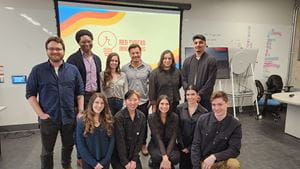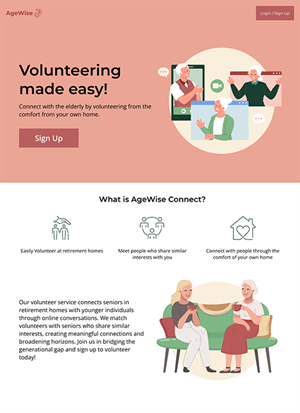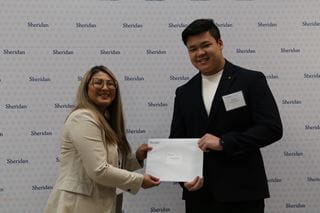.jpg?rev=f6966bda90cf4d6b95706cb303adb861&w=1024&hash=CE6FC6CE415149D7EB1EF0293DC4E054)
Interaction Design students create digital solutions to combat loneliness
 by Marianne Sy-Lucero – Sep 28, 2023
by Marianne Sy-Lucero – Sep 28, 2023
Share on social
Combating loneliness was a top priority for the winning teams during this year’s Red Thread Innovations (RTI) and Interaction Design (IxD) Challenge – a two-phase collaborative assignment that challenges student teams to develop creative solutions to real-world issues.
As part of the Collaborative Workshop courses, fourth-year Bachelor of Interaction Design students worked on the design challenge over two semesters. The students teamed up with RTI last fall to identify opportunity spaces that would significantly benefit from the development of new digital products. After thorough research, three problem spaces were identified – loneliness, immigration and addiction – and teams were tasked with creating digital solutions to address one of the three key issues.
With guidance and feedback from RTI coaches, the next phase required students to explore potential opportunities for digital products within their chosen problem space. Once students identified the specific problem they wanted to solve, teams worked on designing a prototype for their target end user with key features and functionality top-of-mind.
On April 5, teams pitched their digital solutions during the 2023 IxD Year End Show, sponsored by Red Thread Innovations, at Sheridan’s Trafalgar Road Campus in Oakville for a chance to work with RTI’s team to refine their ideas and participate in a design sprint process. This year, two projects were selected as winners: AgeWise Connect by Team Space Jam Lads (Jaiden Armstrong, Adam Borthwick, Julia Correia, Mikaela Delaney and Holly Marshall) and Tomo by Electric Boogaloo (Savannah Dalgado, Malcolm Darko, Natalia Parraga and Jakob Visic.)
 While conducting research, Team Space Jam Lads identified older adults as an underserved market. Despite Canada’s aging population, the team found that the unique needs of older adults are often neglected by organizations, and wanted to design a product that would allow this demographic to take control of how they interact and build connections with others.
While conducting research, Team Space Jam Lads identified older adults as an underserved market. Despite Canada’s aging population, the team found that the unique needs of older adults are often neglected by organizations, and wanted to design a product that would allow this demographic to take control of how they interact and build connections with others.
AgeWise Connect checked all of those boxes as a digital solution that encourages connection and conversation with volunteers, with the aim of reducing loneliness among older adults, especially those in retirement homes. Through the app, older adults can view the profiles of potential volunteers, select a person with similar interests and book time to meet with them via video call.
“During the pandemic, many of us felt isolated, but the difference is that older adults are not as familiar with technology,” explains Delaney. “They often don’t have access to their family and friends on their cell phones like younger generations do. The quarantines may have protected their physical health, but their mental health was not taken into consideration and that will have everlasting consequences.”
 When designing their application, Team Space Jam Lads discussed the potential of using large touchscreens, similar to self-order kiosks found in fast food restaurants. The kiosks would be placed in a stationary location within retirement homes where users can then access the application.
When designing their application, Team Space Jam Lads discussed the potential of using large touchscreens, similar to self-order kiosks found in fast food restaurants. The kiosks would be placed in a stationary location within retirement homes where users can then access the application.
“We wanted to find a way to give older adults more agency, while giving them a simple experience,” says Armstrong. “We also didn’t want to assume that all older adults know absolutely nothing about technology. But if they did need help, we wanted someone in the retirement home to be able to help them use it [AgeWise Connect].”
After approaching Sheridan’s Centre for Elder Research for guidance, the team shifted away from using large screens and decided to optimize their application for use on iPads, which are already frequently used by older adults and staff at retirement homes. In comparison to smartphones, iPads provide a larger screen that is easier for users to navigate, while also being lighter and less bulky than a laptop.
“Our hope is that AgeWise Connect can help older adults get back out there,” says Delaney.
 For Electric Boogaloo, loneliness was a meaningful topic for two reasons: mandated quarantines during the COVID-19 pandemic made it a relatable subject, and the challenge of developing a digital solution for a problem that at first glance requires human connection sparked strong interest for the group.
For Electric Boogaloo, loneliness was a meaningful topic for two reasons: mandated quarantines during the COVID-19 pandemic made it a relatable subject, and the challenge of developing a digital solution for a problem that at first glance requires human connection sparked strong interest for the group.
In contrast to AgeWise Connect, Electric Boogaloo wanted to find a way to encourage positive connections among young adults who are struggling to find support and connection with others.
With technology intertwined in many aspects of our lives, younger generations who have grown up with smartphones, artificial intelligence (AI) and social media as their primary method of communication can feel detached from others and misunderstand how to properly develop relationships.
 To reframe the relationship between humans and technology, the team set out to create Tomo – a pocket-sized AI chatbot that aims to alleviate feelings of loneliness by acting as a social coach for human interactions. By using this application, users can learn strategies to deal with a variety of social issues, including confronting their feelings of isolation, interacting with people to make new friends, or handling rejection.
To reframe the relationship between humans and technology, the team set out to create Tomo – a pocket-sized AI chatbot that aims to alleviate feelings of loneliness by acting as a social coach for human interactions. By using this application, users can learn strategies to deal with a variety of social issues, including confronting their feelings of isolation, interacting with people to make new friends, or handling rejection.
During the initial design stages, Darko recalls pulling inspiration from Spike Jonze’s critically acclaimed film, Her. While the film explores the unhealthy relationship between AI and its user, it motivated Electric Boogaloo to find a way to positively use an AI system that would allow people to step outside of their shells.
“Tomo was designed as a tool to encourage and make users recognize the value of connecting with humans,” explains Darko. “It isn’t meant to be a replacement for human connections, but instead help users gain a wider perspective on how complex interpersonal relationships can be.” The team hopes that people will view Tomo as a “cheerleader” for young adults, adds Parraga.
Sheridan Interaction Design Professor Julia Seo advocates for providing students with opportunities to work with real-world clients, such as RTI, because it gives students a chance to ask for real-time feedback. It also helps validate their design decisions and can guide them to set specific goals throughout their process. “When feedback from a professor is echoed by the client, students understand how concepts and theories in class lectures translate to the work environment,” adds Seo.
“Having the chance to meet and work within a design team with my peers helped us develop the necessary skills to succeed,” says Parraga. “I am grateful for the Collaborative Workshop courses and Red Thread Innovations for helping me develop important soft skills that will be essential to have in the future.”
Participating in design sprints was also a highlight for the teams as it added an air of professionalism and realism to the project, shares Armstrong. “It prepared us for what it would be like in the office and taught us how to work with other designers, the importance of teamwork and leadership, and allowed us to take on different roles.”
For future students and recent graduates, Seo emphasizes the importance of showcasing how client or user feedback is used to make design decisions as a way to make your work stand out, noting that clients want to know that your solution will be used as intended by your audience. Seo adds that conducting various methods of research to validate the problem that has been identified can be another effective way of making a design project stand out.
“The RTI team had a great experience working with Sheridan's students on their project ideas and coaching them along the way,” says Ok Ikejiani, Founder and Chief Innovation Officer at Red Thread Innovations. “We were highly impressed by the caliber of ideas put forward and were excited to offer the winning groups the opportunity to shadow our team for a design sprint. Overall, we're extremely pleased with the outcome of our partnership with Sheridan.”
As part of the Collaborative Workshop courses, fourth-year Bachelor of Interaction Design students worked on the design challenge over two semesters. The students teamed up with RTI last fall to identify opportunity spaces that would significantly benefit from the development of new digital products. After thorough research, three problem spaces were identified – loneliness, immigration and addiction – and teams were tasked with creating digital solutions to address one of the three key issues.
With guidance and feedback from RTI coaches, the next phase required students to explore potential opportunities for digital products within their chosen problem space. Once students identified the specific problem they wanted to solve, teams worked on designing a prototype for their target end user with key features and functionality top-of-mind.
On April 5, teams pitched their digital solutions during the 2023 IxD Year End Show, sponsored by Red Thread Innovations, at Sheridan’s Trafalgar Road Campus in Oakville for a chance to work with RTI’s team to refine their ideas and participate in a design sprint process. This year, two projects were selected as winners: AgeWise Connect by Team Space Jam Lads (Jaiden Armstrong, Adam Borthwick, Julia Correia, Mikaela Delaney and Holly Marshall) and Tomo by Electric Boogaloo (Savannah Dalgado, Malcolm Darko, Natalia Parraga and Jakob Visic.)
Encouraging connection among older adults
 While conducting research, Team Space Jam Lads identified older adults as an underserved market. Despite Canada’s aging population, the team found that the unique needs of older adults are often neglected by organizations, and wanted to design a product that would allow this demographic to take control of how they interact and build connections with others.
While conducting research, Team Space Jam Lads identified older adults as an underserved market. Despite Canada’s aging population, the team found that the unique needs of older adults are often neglected by organizations, and wanted to design a product that would allow this demographic to take control of how they interact and build connections with others. AgeWise Connect checked all of those boxes as a digital solution that encourages connection and conversation with volunteers, with the aim of reducing loneliness among older adults, especially those in retirement homes. Through the app, older adults can view the profiles of potential volunteers, select a person with similar interests and book time to meet with them via video call.
“During the pandemic, many of us felt isolated, but the difference is that older adults are not as familiar with technology,” explains Delaney. “They often don’t have access to their family and friends on their cell phones like younger generations do. The quarantines may have protected their physical health, but their mental health was not taken into consideration and that will have everlasting consequences.”
 When designing their application, Team Space Jam Lads discussed the potential of using large touchscreens, similar to self-order kiosks found in fast food restaurants. The kiosks would be placed in a stationary location within retirement homes where users can then access the application.
When designing their application, Team Space Jam Lads discussed the potential of using large touchscreens, similar to self-order kiosks found in fast food restaurants. The kiosks would be placed in a stationary location within retirement homes where users can then access the application. “We wanted to find a way to give older adults more agency, while giving them a simple experience,” says Armstrong. “We also didn’t want to assume that all older adults know absolutely nothing about technology. But if they did need help, we wanted someone in the retirement home to be able to help them use it [AgeWise Connect].”
After approaching Sheridan’s Centre for Elder Research for guidance, the team shifted away from using large screens and decided to optimize their application for use on iPads, which are already frequently used by older adults and staff at retirement homes. In comparison to smartphones, iPads provide a larger screen that is easier for users to navigate, while also being lighter and less bulky than a laptop.
“Our hope is that AgeWise Connect can help older adults get back out there,” says Delaney.
An AI companion for young adults
 For Electric Boogaloo, loneliness was a meaningful topic for two reasons: mandated quarantines during the COVID-19 pandemic made it a relatable subject, and the challenge of developing a digital solution for a problem that at first glance requires human connection sparked strong interest for the group.
For Electric Boogaloo, loneliness was a meaningful topic for two reasons: mandated quarantines during the COVID-19 pandemic made it a relatable subject, and the challenge of developing a digital solution for a problem that at first glance requires human connection sparked strong interest for the group. In contrast to AgeWise Connect, Electric Boogaloo wanted to find a way to encourage positive connections among young adults who are struggling to find support and connection with others.
With technology intertwined in many aspects of our lives, younger generations who have grown up with smartphones, artificial intelligence (AI) and social media as their primary method of communication can feel detached from others and misunderstand how to properly develop relationships.
 To reframe the relationship between humans and technology, the team set out to create Tomo – a pocket-sized AI chatbot that aims to alleviate feelings of loneliness by acting as a social coach for human interactions. By using this application, users can learn strategies to deal with a variety of social issues, including confronting their feelings of isolation, interacting with people to make new friends, or handling rejection.
To reframe the relationship between humans and technology, the team set out to create Tomo – a pocket-sized AI chatbot that aims to alleviate feelings of loneliness by acting as a social coach for human interactions. By using this application, users can learn strategies to deal with a variety of social issues, including confronting their feelings of isolation, interacting with people to make new friends, or handling rejection. During the initial design stages, Darko recalls pulling inspiration from Spike Jonze’s critically acclaimed film, Her. While the film explores the unhealthy relationship between AI and its user, it motivated Electric Boogaloo to find a way to positively use an AI system that would allow people to step outside of their shells.
“Tomo was designed as a tool to encourage and make users recognize the value of connecting with humans,” explains Darko. “It isn’t meant to be a replacement for human connections, but instead help users gain a wider perspective on how complex interpersonal relationships can be.” The team hopes that people will view Tomo as a “cheerleader” for young adults, adds Parraga.
Experiential learning provides opportunities for growth
Through its partnership with RTI, Sheridan’s Interaction Design program is empowering students to utilize and strengthen their core competencies, conduct primary research and take ownership of their design process to develop solutions to real-world issues.Sheridan Interaction Design Professor Julia Seo advocates for providing students with opportunities to work with real-world clients, such as RTI, because it gives students a chance to ask for real-time feedback. It also helps validate their design decisions and can guide them to set specific goals throughout their process. “When feedback from a professor is echoed by the client, students understand how concepts and theories in class lectures translate to the work environment,” adds Seo.
“Having the chance to meet and work within a design team with my peers helped us develop the necessary skills to succeed,” says Parraga. “I am grateful for the Collaborative Workshop courses and Red Thread Innovations for helping me develop important soft skills that will be essential to have in the future.”
Participating in design sprints was also a highlight for the teams as it added an air of professionalism and realism to the project, shares Armstrong. “It prepared us for what it would be like in the office and taught us how to work with other designers, the importance of teamwork and leadership, and allowed us to take on different roles.”
For future students and recent graduates, Seo emphasizes the importance of showcasing how client or user feedback is used to make design decisions as a way to make your work stand out, noting that clients want to know that your solution will be used as intended by your audience. Seo adds that conducting various methods of research to validate the problem that has been identified can be another effective way of making a design project stand out.
“The RTI team had a great experience working with Sheridan's students on their project ideas and coaching them along the way,” says Ok Ikejiani, Founder and Chief Innovation Officer at Red Thread Innovations. “We were highly impressed by the caliber of ideas put forward and were excited to offer the winning groups the opportunity to shadow our team for a design sprint. Overall, we're extremely pleased with the outcome of our partnership with Sheridan.”
About Red Thread Innovations
Red Thread Innovations (RTI) is a digital product development firm with the sole mission of building meaningful digital products that delight consumers and transform businesses. As a company, RTI is a group of experienced researchers, designers, and engineers who are passionate about innovation and technology, delivering digital experiences for large enterprises, including Telus, Vivid Seats and Capital One and small ambitious startups. RTI’s vision is to be the global leader in digital product development, with the largest portfolio of successful products that empower people across the world to lead their best lives.Media Contact
For media inquiries, contact Sheridan’s Communications and Public Relations team.



